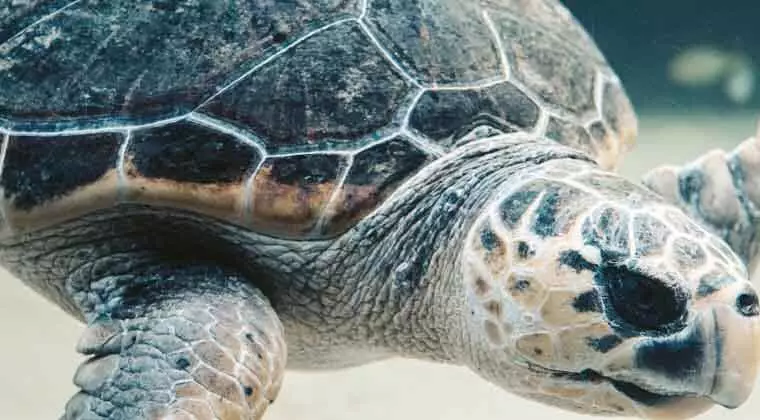Kemp’s Ridley sea turtles are omnivores, meaning they eat both plants and animals. They feed mainly on invertebrates such as crabs, jellyfish, shrimp, mollusks, fish eggs, algae, and tunicates. They also consume seagrass when available.
Young Kemp’s Ridley turtles have been known to occasionally eat small fish or other marine life that they can catch in the water but adult turtles do not typically prey upon fish. Additionally, Kemp’s Ridley sea turtles may scavenge for dead organisms or carrion if it is available.
Kemp’S Ridley Sea Turtle Size
The Kemp’s Ridley sea turtle, also known as the Atlantic Ridley sea turtle, is the smallest species of marine turtle in the world. It typically measures between 70-90 cm (28-35 inches) in length and weighs around 45 kg (99 pounds), which makes it significantly smaller than other types of sea turtles such as Green, Loggerhead, and Leatherback turtles.
This species is mainly found in warm ocean waters and its diet consists mainly of crabs and mollusks. The Kemp’s Ridley sea turtle faces a great challenge from habitat loss due to human activities like coastal development, fishing activities, and pollution.
Kemp’s Ridley Sea Turtle Adaptations
The Kemp’s Ridley sea turtle is the smallest species of sea turtle, and they have adapted several unique features to help them survive in their environment. These turtles have streamlined bodies with ridged carapaces that allow them to move quickly through the water.
They also possess long claws on each flipper which helps them grip rocks and other surfaces while looking for food or nesting sites. Additionally, their diet consists mainly of crabs which provide them with an adequate source of energy for swimming long distances and avoiding predators.
What Eats Kemp Ridley Sea Turtles?
Kemp Ridley Sea Turtles are omnivorous and feed on a variety of organisms including mollusks, crustaceans, algae, fish eggs, jellyfish, and sea urchins. They also occasionally eat carrion or floating debris. As juveniles, they tend to be more carnivorous and as adults become increasingly herbivorous.
Predators of the Kemp Ridley Sea Turtle include larger marine animals such as sharks, barracudas, and other large fish species; birds such as gulls; land predators like raccoons when nesting females come ashore; humans who poach turtles for their meat and shells; and even other turtles that may steal eggs from nests.
Where Are Kemp Ridley Sea Turtles Found?
Kemp Ridley Sea Turtles, also known as the Atlantic Ridley Sea Turtle, are found in tropical and subtropical waters across the world. They migrate between their nesting grounds on beaches of Mexico’s Gulf Coast to foraging areas that extend from North Carolina down to northern South America.
These turtles have an amazing connection with humans: after hatching on Mexican beaches, they make a journey all the way up to Massachusetts! It is believed that this incredible migration helps keep their populations healthy and stable amongst diverse habitats.
Why is the Kemp’S Ridley Sea Turtle Endangered?
The Kemp’s Ridley sea turtle is critically endangered due to human activities such as over-harvesting of eggs and bycatch in fishing nets. Other factors that have contributed to their endangerment include coastal development, pollution, habitat destruction, and climate change.
To help conserve this species, conservation efforts have been put into place such as protecting nesting beaches from disturbance during the nesting season and establishing captive breeding programs for release into the wild.
How Many Kemp’s Ridley Sea Turtles Are Left?
According to the World Wildlife Fund, there are only around 1,000 nesting females of Kemp’s Ridley sea turtles left in the world. This number is a drastic decline from estimates made decades ago when it was believed that tens of thousands were still alive.
The decline has been attributed to human activities such as overfishing and habitat destruction. Fortunately, conservation efforts have been successful in recent years and the population appears to be increasing slowly but steadily.
How Long Do Kemp’s Ridley Sea Turtles Live?
Kemp’s Ridley sea turtles are one of the world’s smallest and most endangered species. They typically live between 50-70 years in the wild, although some individuals have been known to reach up to 100 years old.
These turtles spend most of their lives in shallow waters near shorelines where they feed on a variety of prey such as crabs, jellyfish, and shrimp. Kemp’s Ridley sea turtles also nest along beaches from Texas to Mexico, which is why conservation efforts for this species are so important to protect them from extinction.
Kemp’s Ridley Feeding (16-1813)
Conclusion
Kemp’s Ridley sea turtles have a diverse diet which is comprised of both aquatic and terrestrial species. They primarily feed on crustaceans such as crabs and shrimp, along with mollusks like clams, urchins, and whelks.
Additionally, they will also consume jellyfish, algae, fish eggs, or even carrion when available. Conservation efforts to protect this endangered species must focus not only on their habitats but also on the availability of their food sources.
